I did not sleep well the night before the trip to Ayutthaya and when I left the hotel, I felt pain in my right knee that first appeared shortly before the trip to Thailand. It wasn’t severe, but it was extremely discouraging and it affected my mood. However, I didn’t know what else to do, so I headed towards the main street, being careful about how I walked because there was an angle at which my knee bothered me less. It was fortunate that I had first felt the pain before this journey, so I brought a pair of elastic knee supports from Belgrade, which, as it turned out, came in handy and helped me.
I took a taxi to the Mo Chit station for minibuses and boarded one that went directly to Ayutthaya.
While sitting, I didn’t feel any pain in my knee, but I worried. That’s why I tried not to think too much about it; instead, I looked out the window and admired the fantastic infrastructure of Bangkok as we passed by.
Bangkok is estimated to have over 11 million inhabitants. When it comes to vehicles, their number seems endless. This creates a constant impression of heavy traffic on the streets. As I headed north in the minibus, besides a few lanes in one direction on the road we were travelling, I realised that parallel to this highway, elevated on massive concrete pillars, there was a fast elevated highway and an elevated railway, also supported by massive concrete pillars.
I have to admit that I came to Thailand apparently with preconceptions. Namely, this country is often mentioned in the context of mass tourism, as a place where everything is cheap, and over time, this created the impression in me that it is a very poor country. While there are certainly many impoverished residents in Thailand, judging by the exceptionally impressive infrastructure that I could often observe during the month spent in this wonderful and exotic country, my conclusion is that Thailand is anything but a poor country. I am talking here about personal impressions and thoughts, not economic indicators, GDP, income per capita, etc. Those data don’t interest me much, although they can certainly be found on the internet if someone is particularly curious about that aspect.
After about an hour and a half of driving by minibus through what seemed like an uninterrupted urban landscape (as if Bangkok and Ayutthaya were connected), I arrived at my destination. However, as soon as I got out of the minibus in Ayutthaya, some local tuk-tuk drivers swarmed around me. I don’t like being approached so aggressively, although I understand that these people make a living from it. Moreover, the knee that I hadn’t felt during the journey instantly started hurting as soon as I began to walk after getting off the minibus, which made me extremely nervous. So, I coldly rejected any communication with the tuk-tuk drivers. While seemingly walking in a funny way (taking care of my knee), I crossed the street and on the opposite side I spotted a place where I could have some coffee. I decided to wake up some more and calm down a bit first, and then figure out what to do.
After having a cup of coffee and calming my nervousness a bit, I headed towards the nearest temples within the historical park of Ayutthaya. After all, I had already arrived and sightseeing was the main purpose of this trip, as well as of the entire journey in Thailand. Considering my physical condition, I walked very carefully and the knee pain gradually subsided. I felt that my leg responded better when it warmed up a bit, but I had to be cautious to reach that stage. All in all, I must say that on this day, I managed to visit practically everything I wanted, except for the museum, but that wasn’t my fault. It was Monday and the museum was closed. I understand that museums are usually closed on Mondays and I understand why (employees need a day off), but I have to admit that it bothers me a lot in places like this. They could hire someone else and the museum could be open every day, just like the entire historical park.
My plan was to go first to the farthest of the important temples, but fortunately, that plan fell through. I say this because I really liked how I ended up organising myself. I was trying to hail a tuk-tuk on the way, as I didn’t want any of those waiting for tourists at the station, but there were no tuk-tuks on the street. So, I slowly walked to the place where two important temples, Wat Ratchaburana and Wat Mahathat, are located almost side by side.
Here is also a map that shows the places I visited during my sightseeing of the Ayutthaya site:
But before I start talking about my visit, let me say something about Ayutthaya.
Today, it is a city with around 50,000 residents and its main urban area is located on a large island at the confluence of the Chao Phraya and Pa Sak rivers. On that same island, once stood the centre of the Siamese Kingdom of Ayutthaya (1350-1767), specifically its capital, also called Ayutthaya. I will talk more about the kingdom and the capital a bit later, in between stories about visiting the remains of various temples.
Let me just mention that the founder of the Chakri Dynasty, which still rules Thailand today, King Rama I (b/r 1737/1782-1809), was born in Ayutthaya. The city got its name from the city of Ayodhya in India, where, according to the legend, Rama, a Hindu deity and the seventh avatar of god Vishnu, was born. Rama is the main character in the famous Indian epic Ramayana.
So, when I reached the first temples or, rather, their remains, I first headed to Wat Ratchaburana.
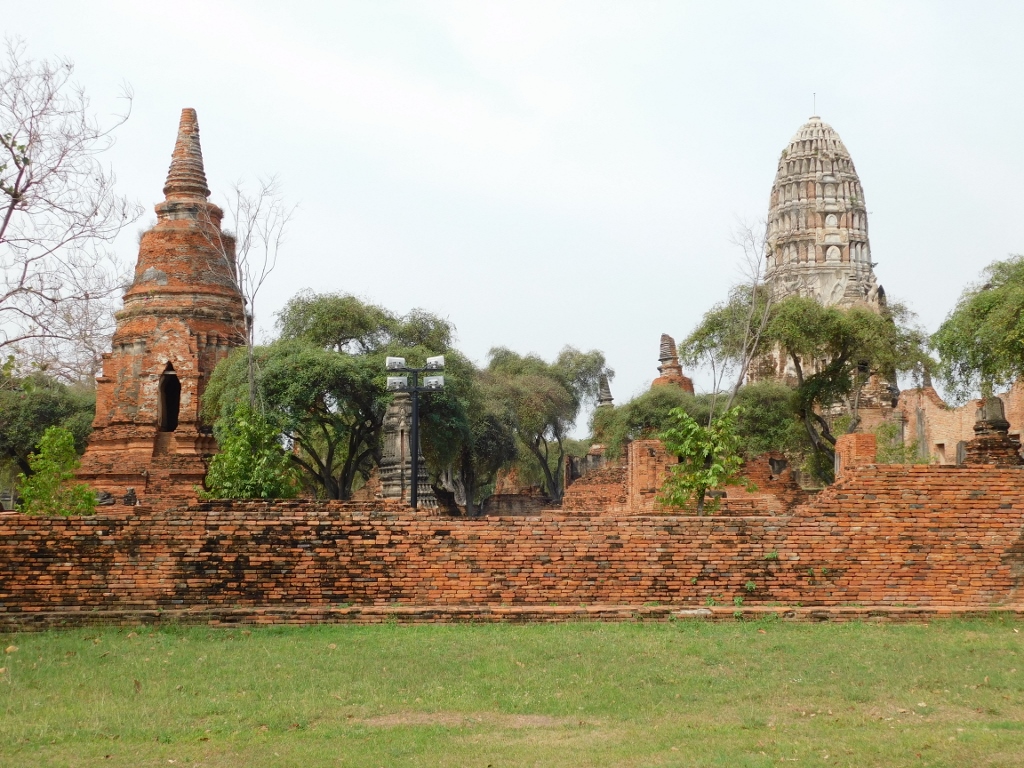 Ayutthaya: Wat Ratchaburana
Ayutthaya: Wat Ratchaburana
The temple was founded in 1424 by King Borom Rachathirat II (b/r 1386/1424-1448) on the site where the cremated remains of his two older brothers, who fought (apparently unsuccessfully) for the throne, were placed. Due to these events, Wat Ratchaburana served as the royal temple during the Ayutthaya Kingdom.
The temple has a simple ground plan, in the form of a rectangle with a central pagoda or prang, surrounded by a cloister or rather a covered walkway. In front of the prang there is a vihara, the ground plan of which is shaped like an elongated rectangle.
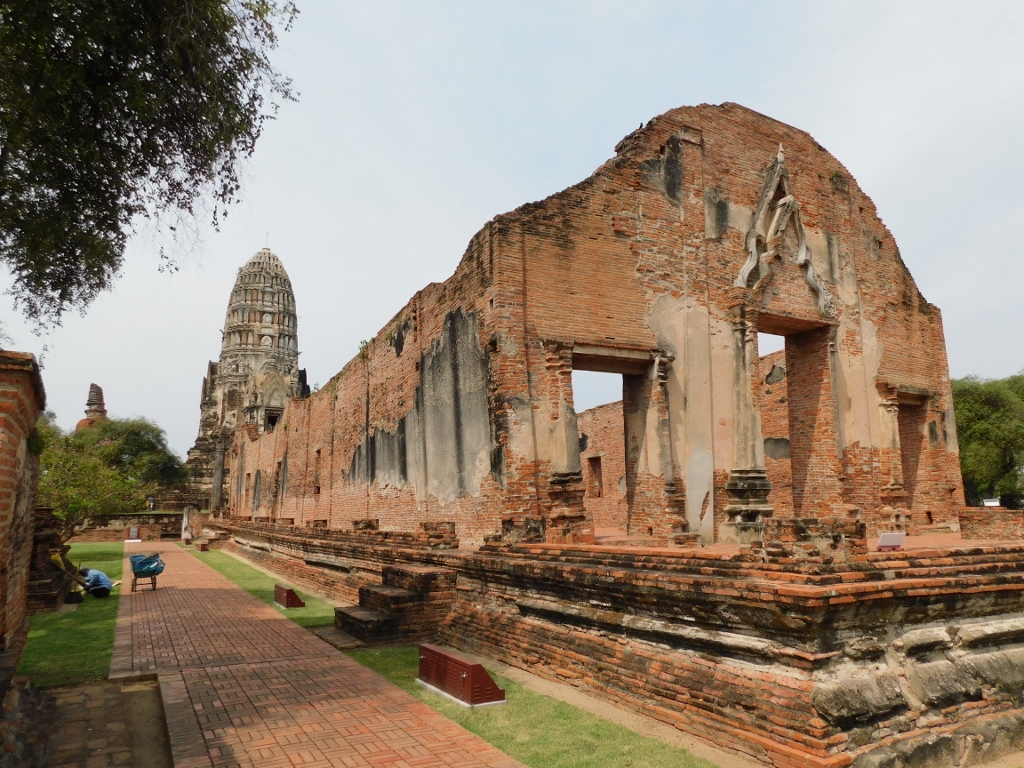 Wat Ratchaburana: the vihara, with the prang in the background
Wat Ratchaburana: the vihara, with the prang in the background
Behind the prang, on the same axis as the vihara, there are the remains of the ubosot that is almost identical to the vihara at the front.
I’ve already mentioned these terms before – prang, vihara, ubosot, etc. – and I think it’s good for every visitor exploring such places in Thailand to become familiar with these terms. There are translations for each of these words, but different versions of translations (as well as different forms of transcription – vihara, viharn) can be found, which can be confusing. At least it confuses me. On the other hand, it’s clear that the function and differences between these structures are conditioned by the Buddhist religion and needs, which is too complex a topic for me to delve into. Therefore, I will regularly use these terms in my stories and only occasionally provide a reminder of some of their translations that suggest at least a part of their function.
So, this vihara in Wat Ratchaburana is usually referred to as the “sermon hall.”
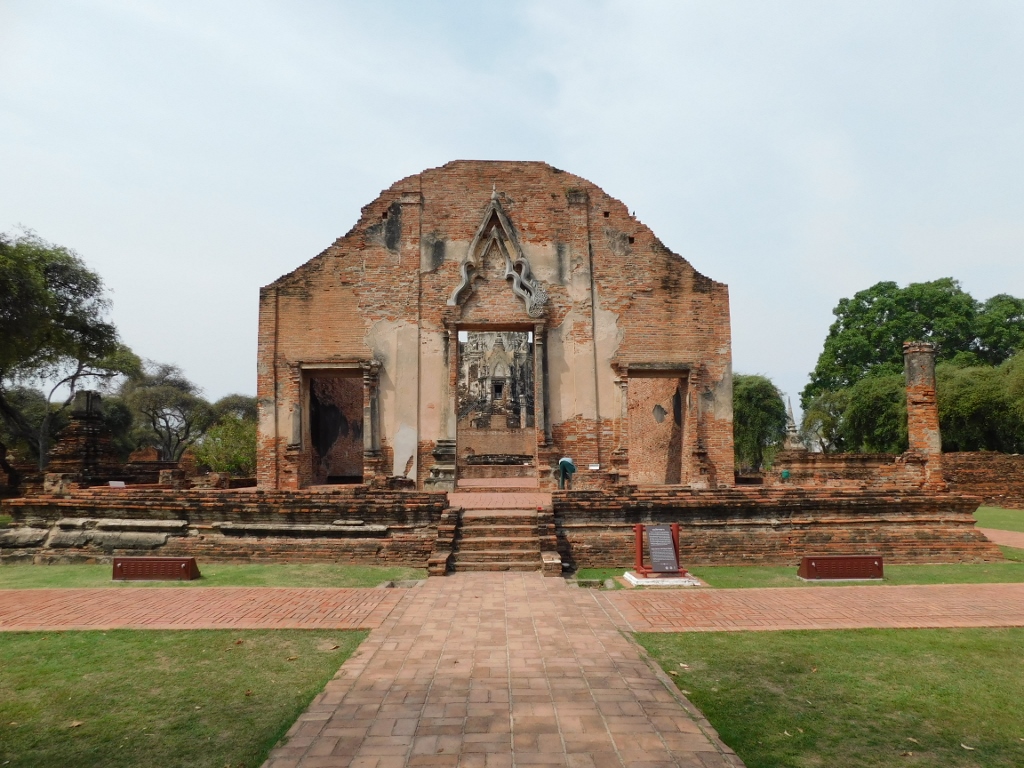 Wat Ratchaburana: the front facade of the vihara
Wat Ratchaburana: the front facade of the vihara
When you start to climb here, you can clearly see the layout where, along the same line behind the vihara in the east, follows the prang and, as I’ve mentioned, behind the prang in the west is the ubosot.
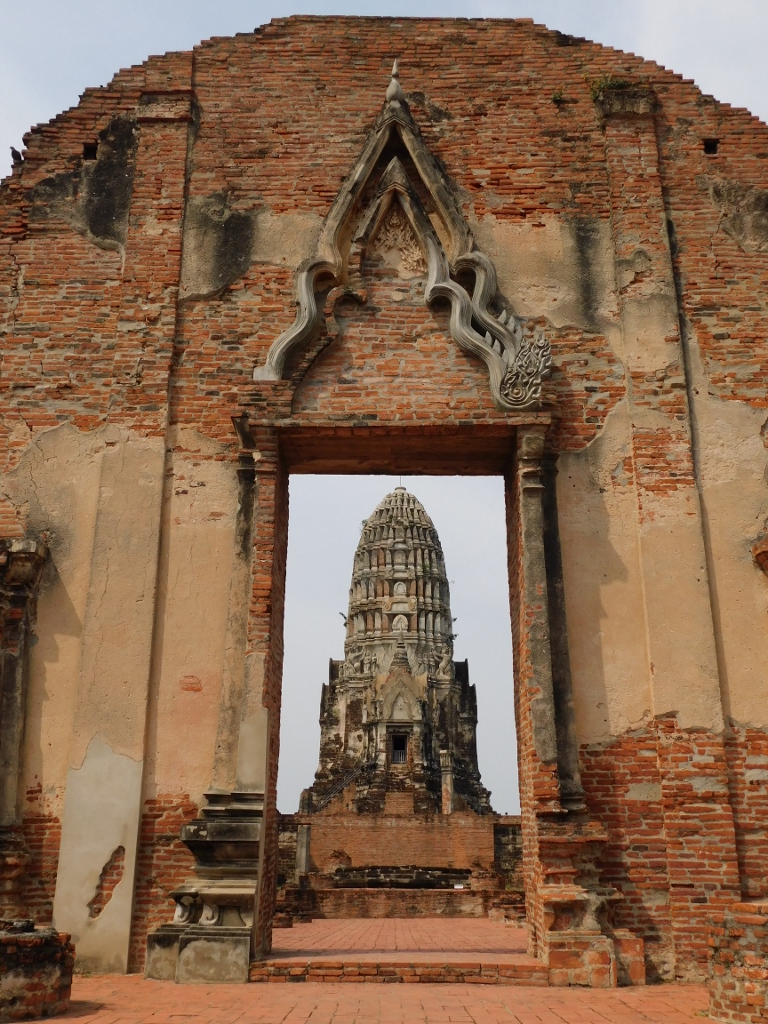 Wat Ratchaburana: the front facade of the vihara
Wat Ratchaburana: the front facade of the vihara
The vihara is constructed from bricks bound by mortar and on the front and back sides, there are porches. The remains of the front porch are clearly visible in one of the previous photos taken from the side and with the prang in the background. On the front facade, there are three doorways, with the middle one larger than the side ones, decorated with relief stucco-style ornamentation. The back porch is connected to the cloister that surrounds the prang.
Upon entering the vihara, it’s clear that the floor is of modern date, but that doesn’t detract in the slightest and even facilitates the visit.
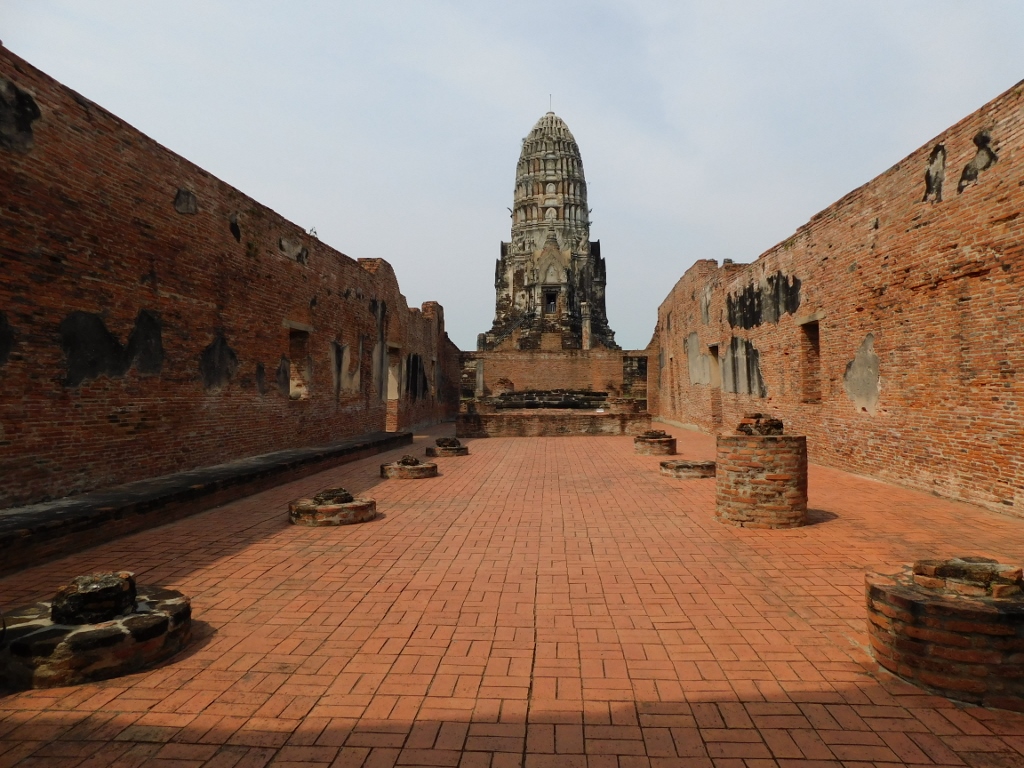 Wat Ratchaburana: the interior of the vihara
Wat Ratchaburana: the interior of the vihara
I took advantage of the favourable position of the vihara and the openness of the space to capture some details of the prang that I later dealt more with. Everything was so impressive that it truly inspired me.
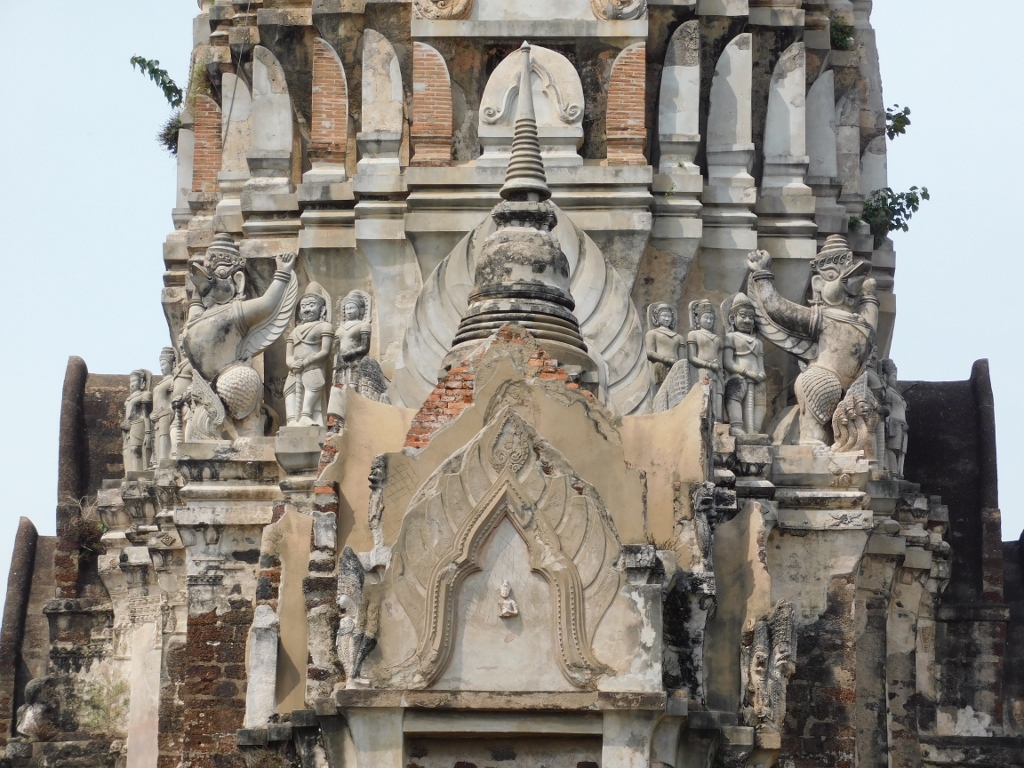 Wat Ratchaburana: details of the prang
Wat Ratchaburana: details of the prang
In the end, by walking through one of the side passages and using the staircase on that side, I descended from the vihara. But first, I took a photo of a part of the site to the north of there.
 Wat Ratchaburana: a detail
Wat Ratchaburana: a detail
I then took a short walk around the site, exploring the area around the prang. There are numerous chedis or stupas and remains of various structures. Experts who worked on the excavations have also arranged fragments of Buddha statues on some of the platforms. It’s crucial to remember that the Thai people are deeply committed to Buddhism and even damaged Buddha sculptures are considered sacred. Visitors should treat them accordingly. At several locations, signs make it clear that climbing on various structures is prohibited (except in clearly designated areas), including Buddha statues that can be sufficiently large and inspiring for “creative” visitors.
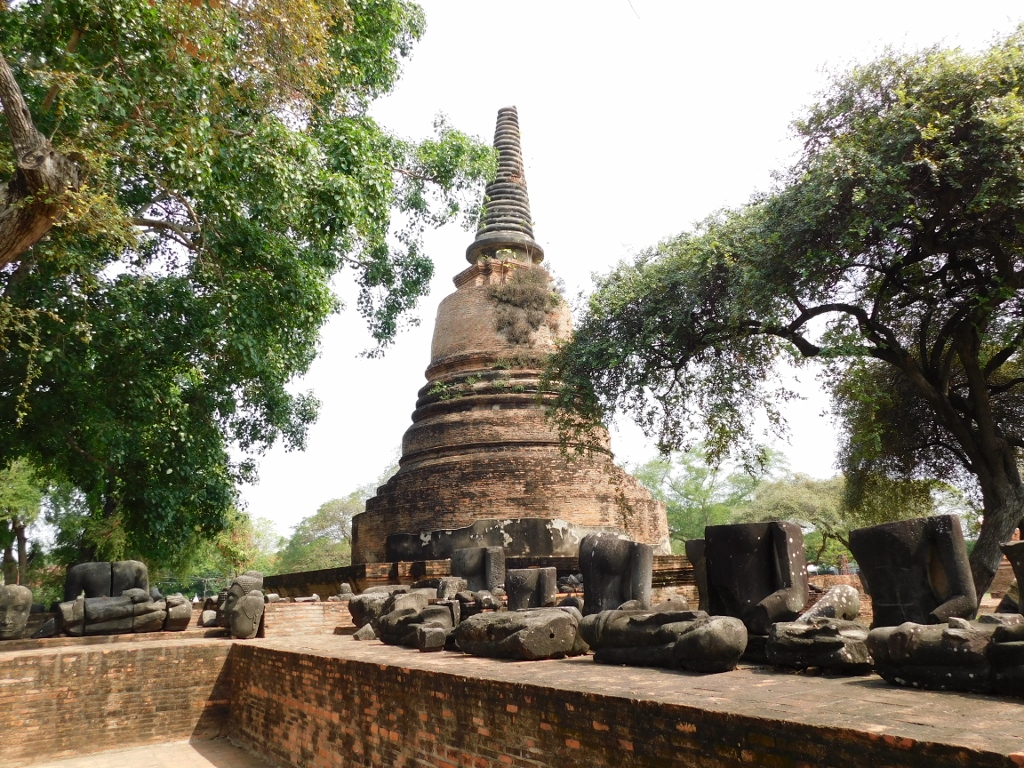 Wat Ratchaburana: a detail
Wat Ratchaburana: a detail
In addition to exploring various parts of the site, I also made an effort to move from one tree shade to another. It was already late morning and the sun was intense, so I tried to pass quickly through the sunny areas and take pictures only when standing in the shade.
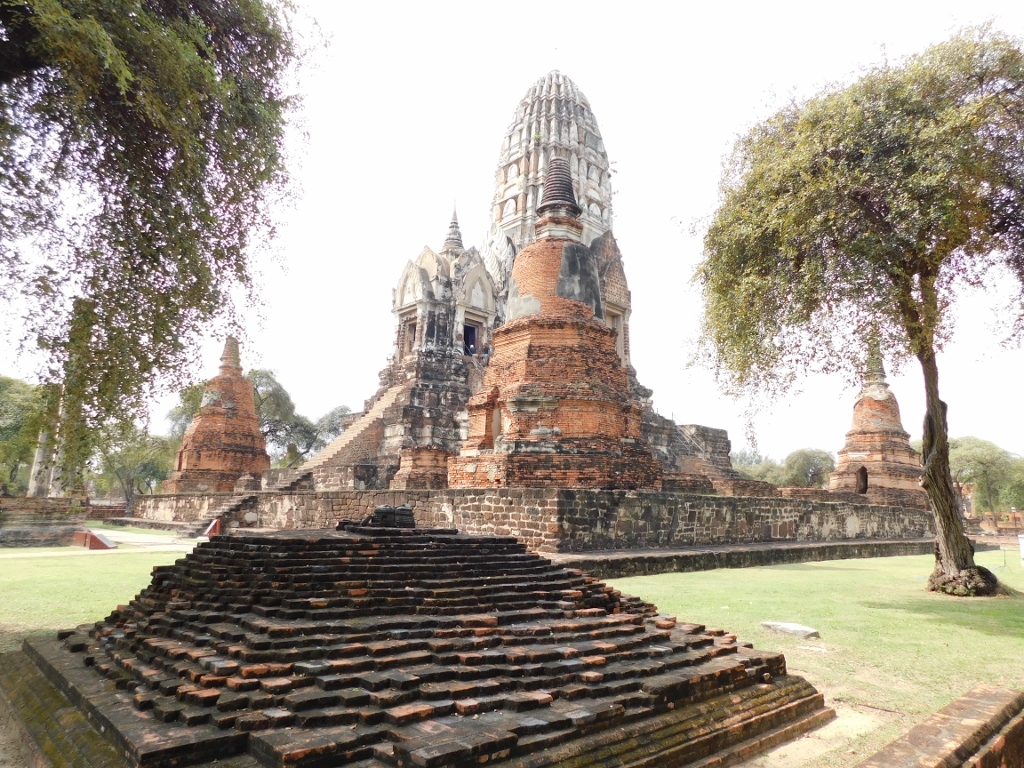 Wat Ratchaburana: a detail
Wat Ratchaburana: a detail
Thus, I reached the ubosot as well, but only realised upon returning home that I hadn’t photographed it once. I wasn’t too concerned about it because it’s almost identical to the vihara. So, while chasing shadows and casually observing different parts of the temple ruins, I reached the southern side of the prang. There, you could clearly see one of the four large stupas adorning the corners of the square platform on which the prang rises, along with the remains of a structure in the middle of the wall, featuring impressive decorative figures above the socle.
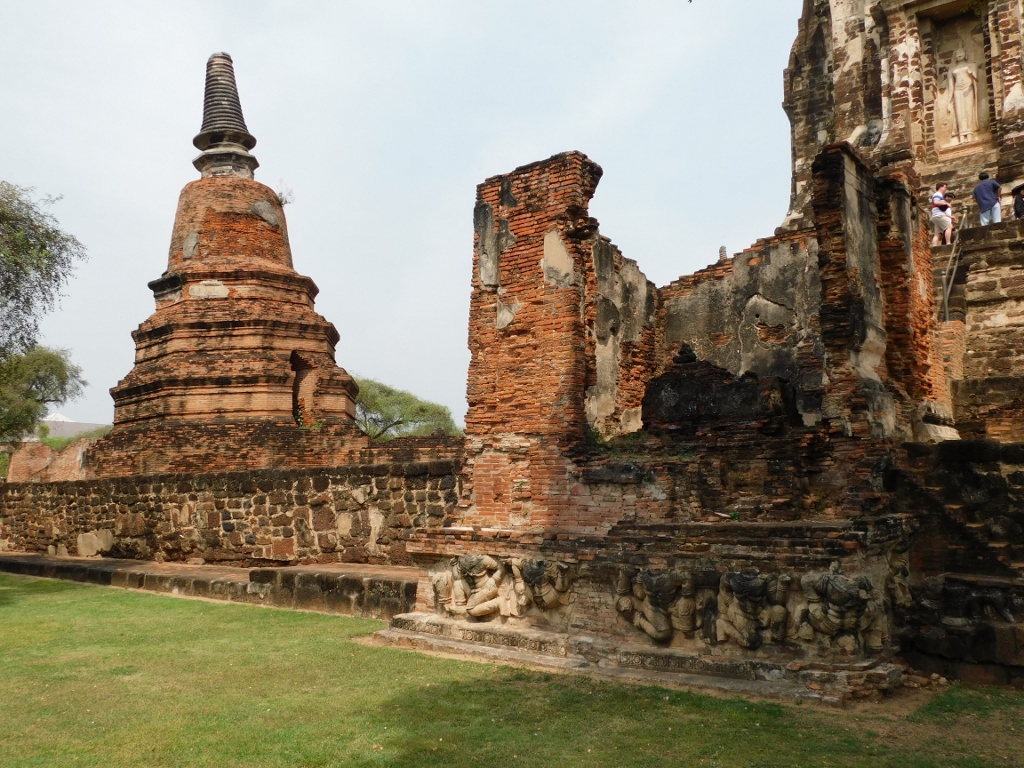 Wat Ratchaburana: a detail
Wat Ratchaburana: a detail
From almost the same spot, I photographed the prang and you can see the stairs leading up to the platform and further to the prang itself.
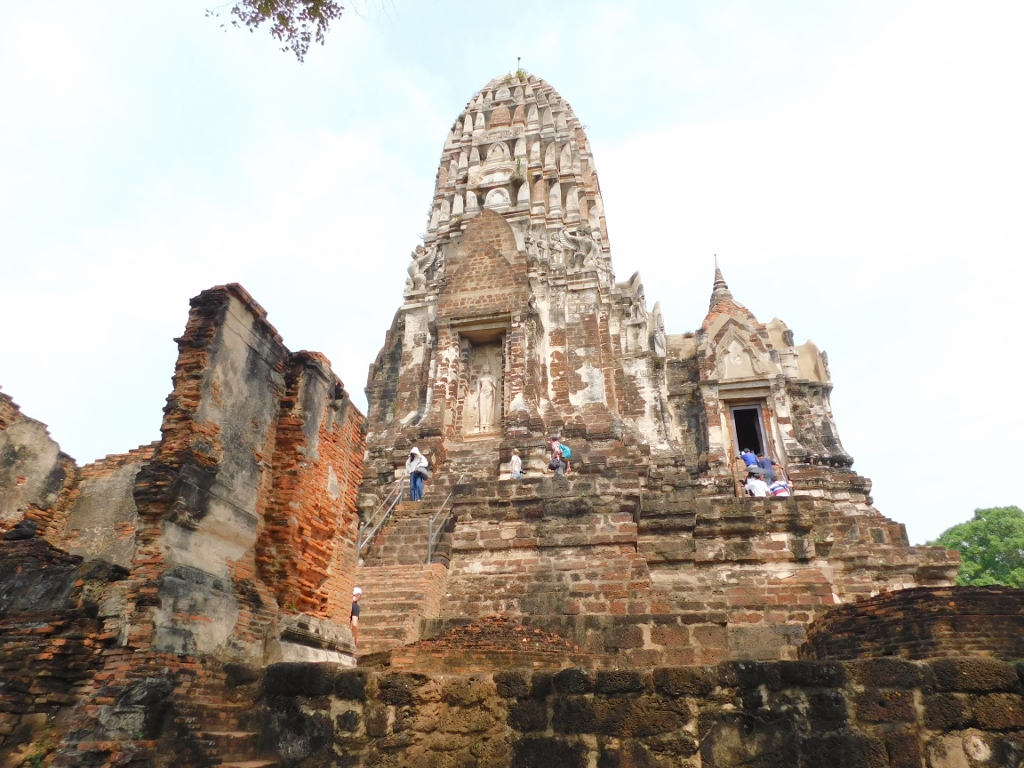 Wat Ratchaburana: a detail
Wat Ratchaburana: a detail
Once I climbed to the base of the prang, I first took a photo of the remains of the cloister that surrounds the inner courtyard around the prang on all four sides, while behind the cloister, you can see the remains of chedis or stupas.
 Wat Ratchaburana: a detail
Wat Ratchaburana: a detail
Chedi and stupa are practically synonymous, with the main difference being that “stupa” is the term in Sanskrit, while “chedi” is the term in the Thai language. Both terms refer to structures that house the relics of the Buddha or various holy Buddhists. When containing the relics of the Buddha, the chedis or stupas are seen as the embodiment of the Buddha himself and, as such, they become the most important object within a Buddhist temple.
I tend to think that the term “chedi” should be used here, as everything is happening in Thailand, but many sources use the term “stupa,” so I tend to use both versions of the term.
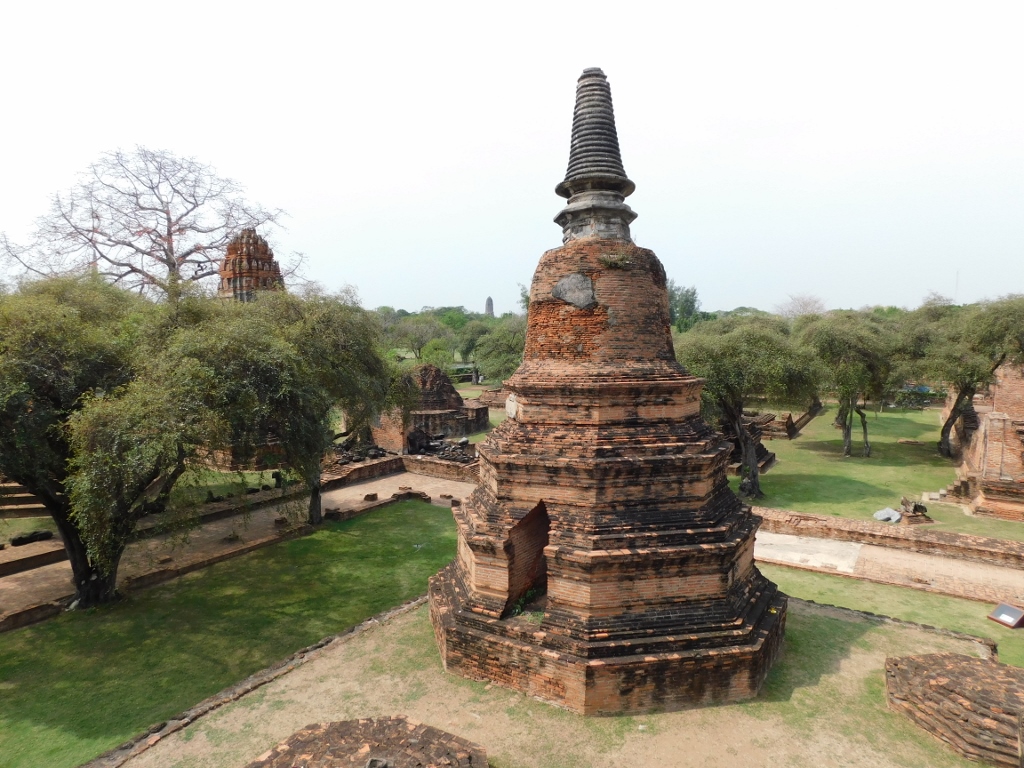 Wat Ratchaburana: one of the four chedis on the corners of the platform with the prang
Wat Ratchaburana: one of the four chedis on the corners of the platform with the prang
Before I went to visit the interior of the prang, I looked at and took photos of the vihara. In the photo below, you can see its back porch quite nicely, with a damaged Buddha statue placed on a pedestal. Also, from this perspective, you can see how the vihara is connected to the cloister.
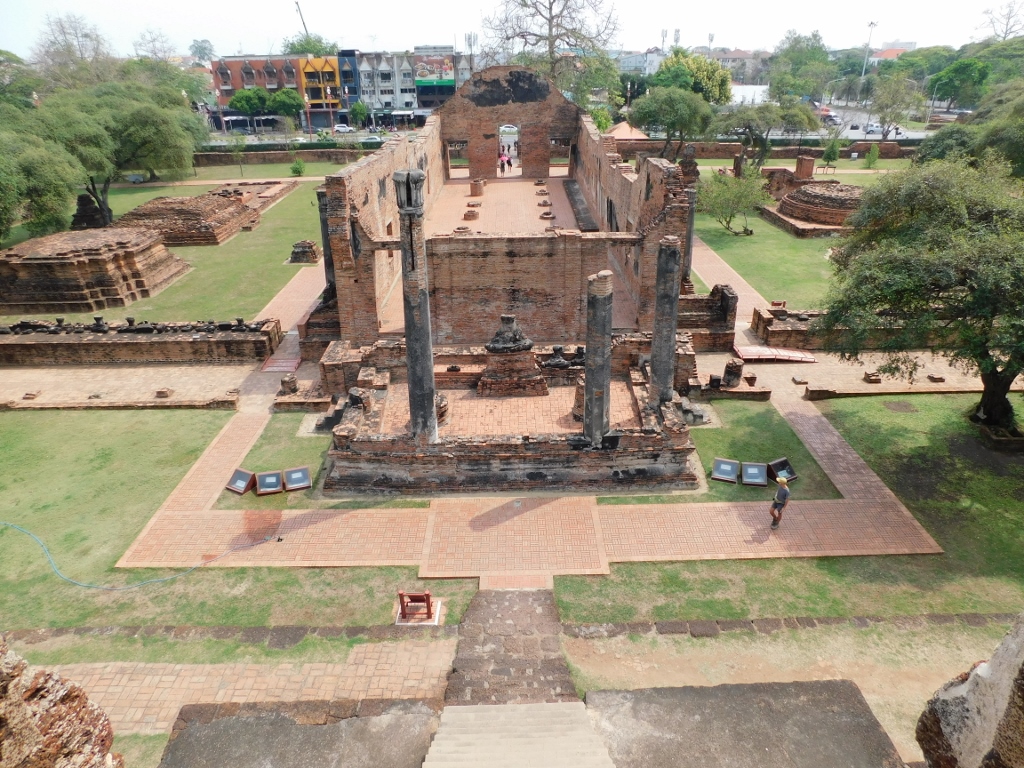 Wat Ratchaburana: the vihara
Wat Ratchaburana: the vihara
And as for the prang, let me first remind you of the meaning of the term. It is a tower erected within a temple in the form of a spire or cone, while as an architectural element, it originates from the Khmer architecture, but the Buddhist builders in Thailand adapted it to their needs. The construction of prangs was particularly popular during the Ayutthaya Kingdom (1350-1767) and later during the Rattanakosin Kingdom (1782–1932). Prangs can be seen only in the most important Buddhist temples. I’ve previously mentioned and photographed the prang in the Wat Arun temple in Bangkok (see: https://www.svudapodji.com/en/thailand-9/), where I explained its symbolic significance (Mount Meru and the rest of it).
The prang of Wat Ratchaburana is one of the best-preserved in Ayutthaya and is now one of the symbols of the city. The visitors are even allowed to climb and enter the interior of the prang.
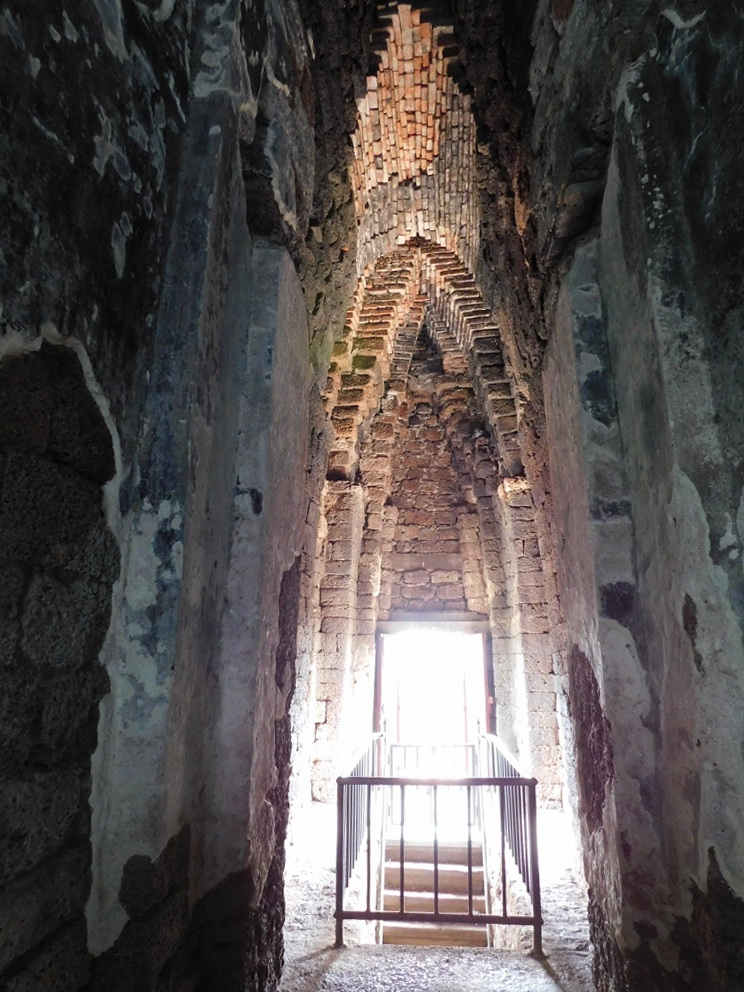 Wat Ratchaburana: the interior of the prang
Wat Ratchaburana: the interior of the prang
The interior of the prang is interesting for a couple of reasons. On the one hand, there are impressive murals from the 15th century and in order to see them, the visitors need to descend 15 meters into the crypt. However, when I was here, the access to the crypt was closed. It is also fascinating to come here to understand better the story of the 1957 robbery when thieves managed to access a room from where they stole numerous golden objects. It is estimated that there were objects made of pure gold in that room, with a total weight of over 100 kg. Eventually the authorities managed to catch the thieves, but only a small part of their loot was returned and over time it was transferred to the Chao Sam Phraya National Museum. This is the same museum in Ayutthaya that I mentioned was closed on Mondays, so I didn’t visit it.
All in all, I concluded my visit to the interior of the prang and the Wat Ratchaburana temple here, so I descended to the inner courtyard, but I still enjoyed the beauty of the prang and its details. Even today, the prang features huge figures of Garuda, a deity often depicted as a bird, crafted in the stucco technique. There are also nagas (semidivine deities in the shape of snakes) and standing figures. Even after so many centuries, all of this is breathtaking.
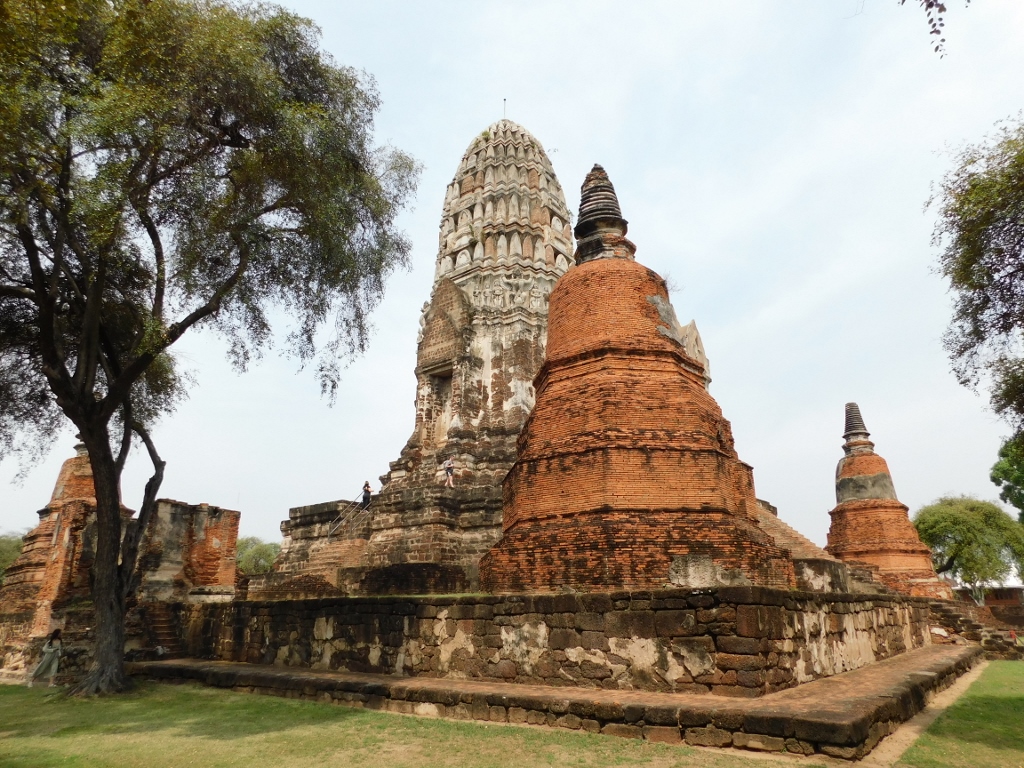 Wat Ratchaburana: the view at the prang and the chedis
Wat Ratchaburana: the view at the prang and the chedis
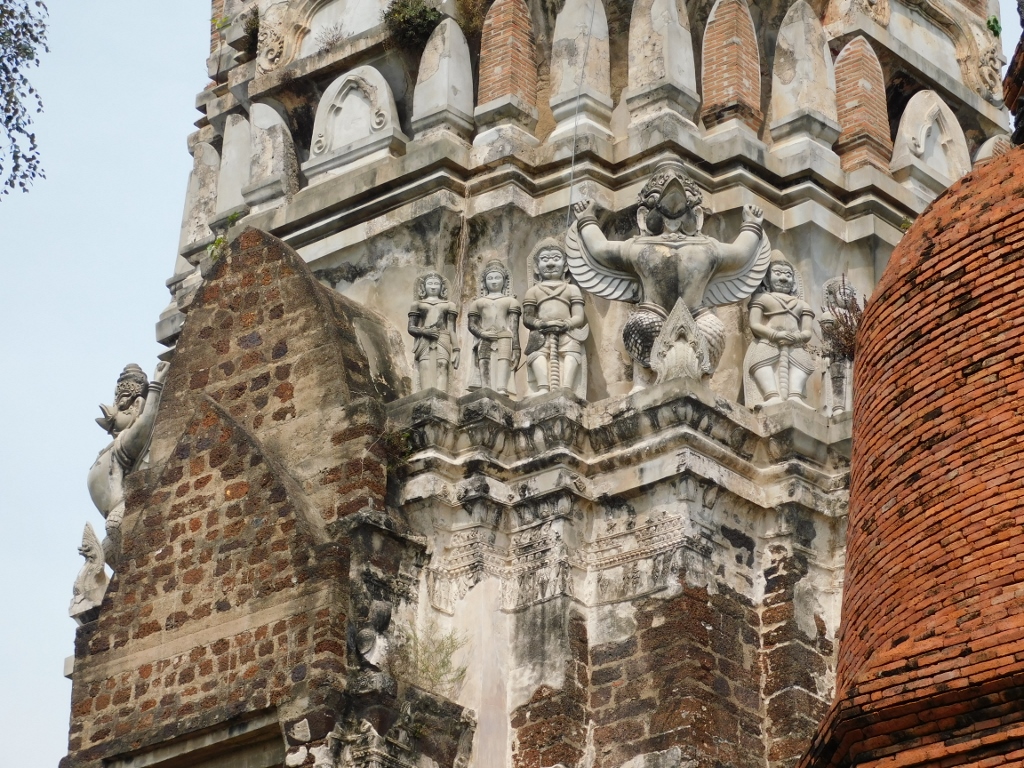 Wat Ratchaburana: details of the prang
Wat Ratchaburana: details of the prang
Now I headed towards the neighbouring temple, Wat Mahathat. It was almost noon and it was very hot, with the sun’s rays scorching. Each visitor was doing their best to cope, carrying umbrellas (used as sunshades), hats, and the like. However, one girl completely surprised me. I understand fashion and trends, but wearing a ‘fur’ hat at 35 degrees C!?
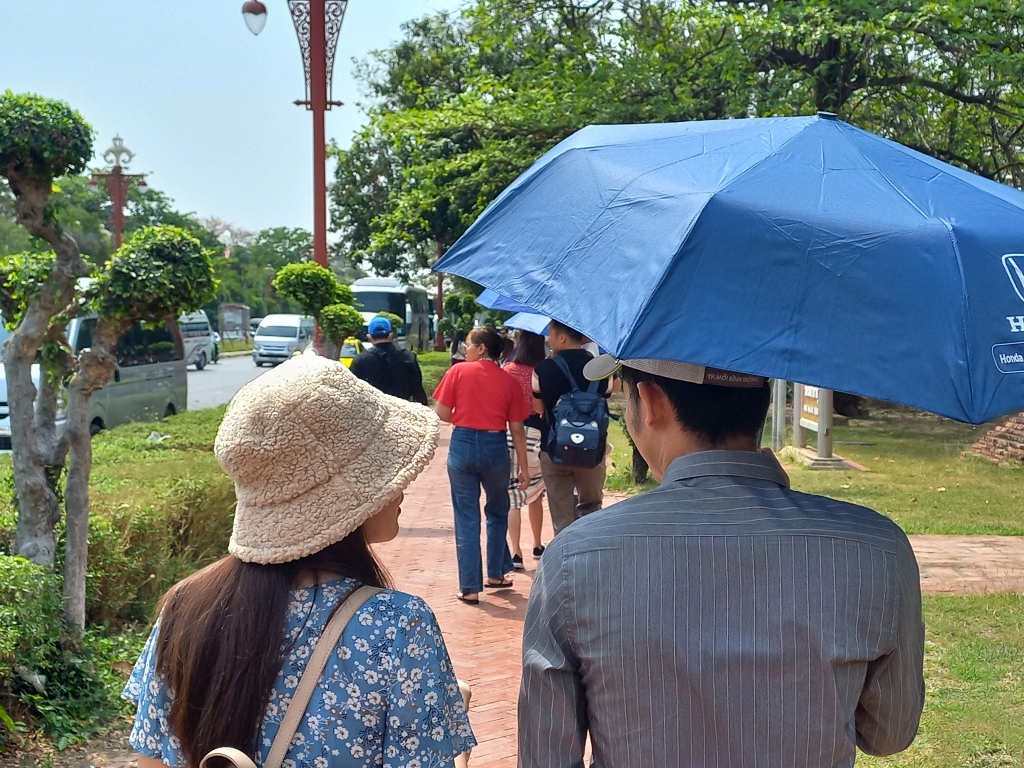 Fashion details at 35 degrees C
Fashion details at 35 degrees C
Nevertheless, it was amusing for me to see her walking in front of me and even taking a photo of her. On the other hand, we are all different and youth as a life phenomenon tends to emphasise fashion and trends. Back in the day, I also wore only cotton leggings on Mount Durmitor in January when the temperature was constantly below zero because I wanted to imagine myself as a “hot chick.” To put it mildly: “Blessed is the youth!!!”
Now, let me go back with my story to the Wat Mahathat temple that could be clearly seen from the street.
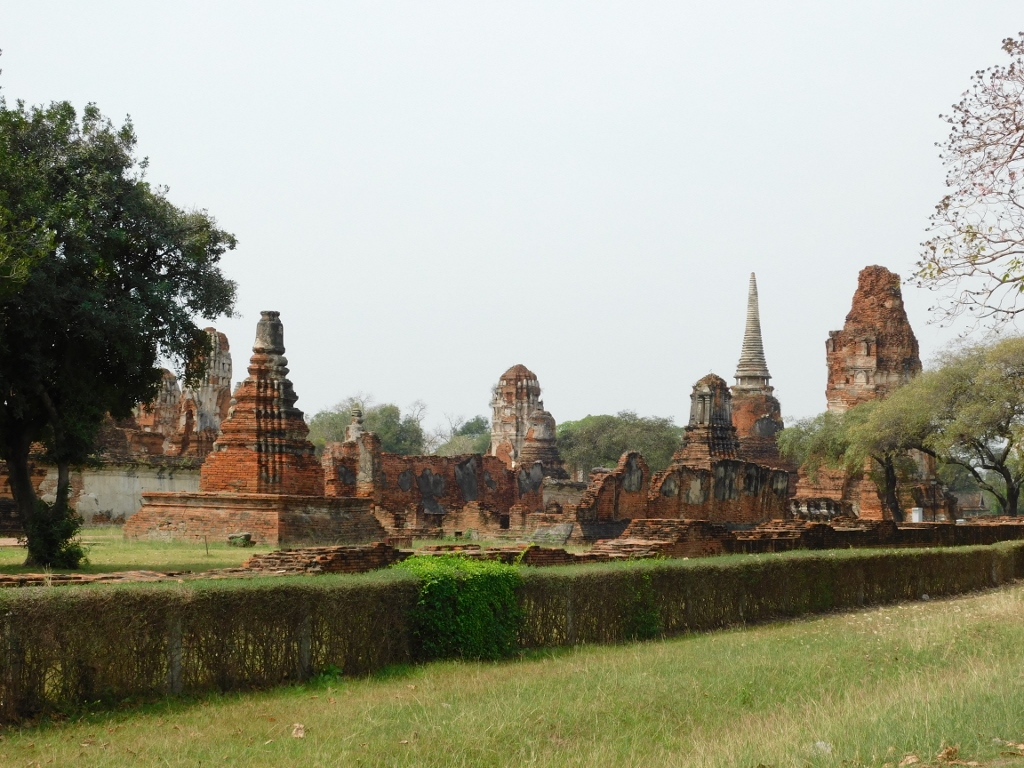 Wat Mahathat
Wat Mahathat
The construction of the temple began in 1374 under the rule of the third monarch of the Ayutthaya Kingdom, King Borom Rachathirat I (1370-1388). However, it was completed during the reign of the next monarch. This temple used to house a holy relic of the Buddha and was the most important temple during the time of the Ayutthaya Kingdom, serving as the seat of the supreme spiritual leader.
Today, it is one of the most popular temples among visitors due to its multitude of interesting details. In the photo below, you can see the octagonal chedi and, in the distance, the prang of Wat Ratchaburana.
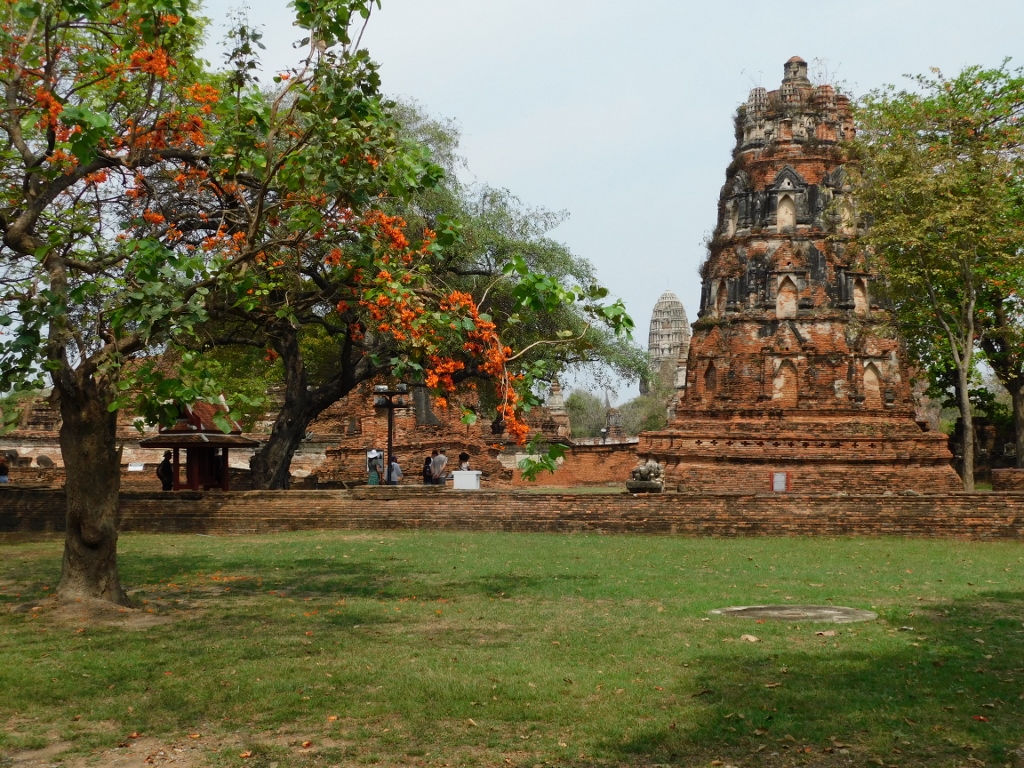 Wat Mahathat, a detail
Wat Mahathat, a detail
 Wat Mahathat
Wat Mahathat
Here, too, there was a main pagoda or prang that was almost 50 meters high but it collapsed at some point. It was then reconstructed in 1633. After the fall of Ayutthaya in 1767, the Burmese, responsible for the kingdom’s demise, set fire to the temple, causing damage to the prang again. The central prang was reconstructed once more, but it collapsed again in the early 20th century. Today, it has been partially restored and can be seen in the middle of the previous photo. On the other hand, there are numerous quite interesting and picturesque smaller prangs and chedis at the site.
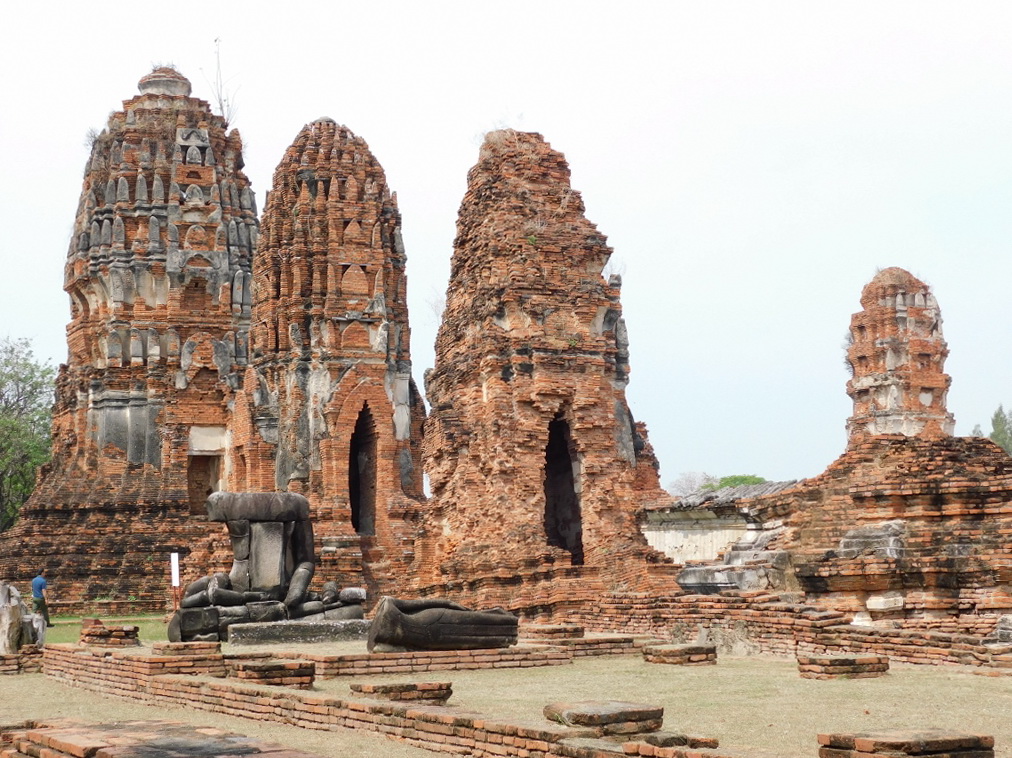 Wat Mahathat, a detail
Wat Mahathat, a detail
By the way, many of these prangs or chedis stand a bit tilted today, probably due to poor foundations or some damage, but I hope they are well conserved.
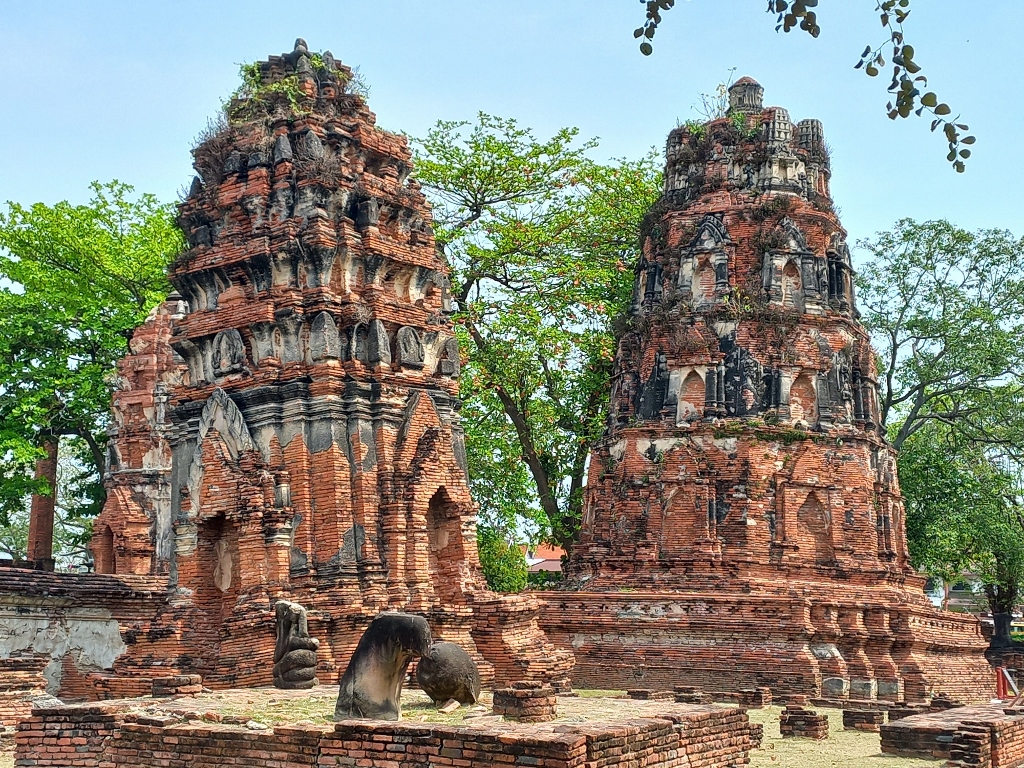 Wat Mahathat, a detail
Wat Mahathat, a detail
One of the particularly interesting structures is the octagonal chedi with four levels, each smaller than the previous one. Looking at the chedi, it’s clear how these structures were built and finished – the base is made of bricks and mortar to create the desired shape and then a mixed material that can be shaped (using the stucco technique) is applied, which is undoubtedly cheaper and easier than creating such forms from pure stone. The fourth level of the chedi is decorated with miniature prangs.
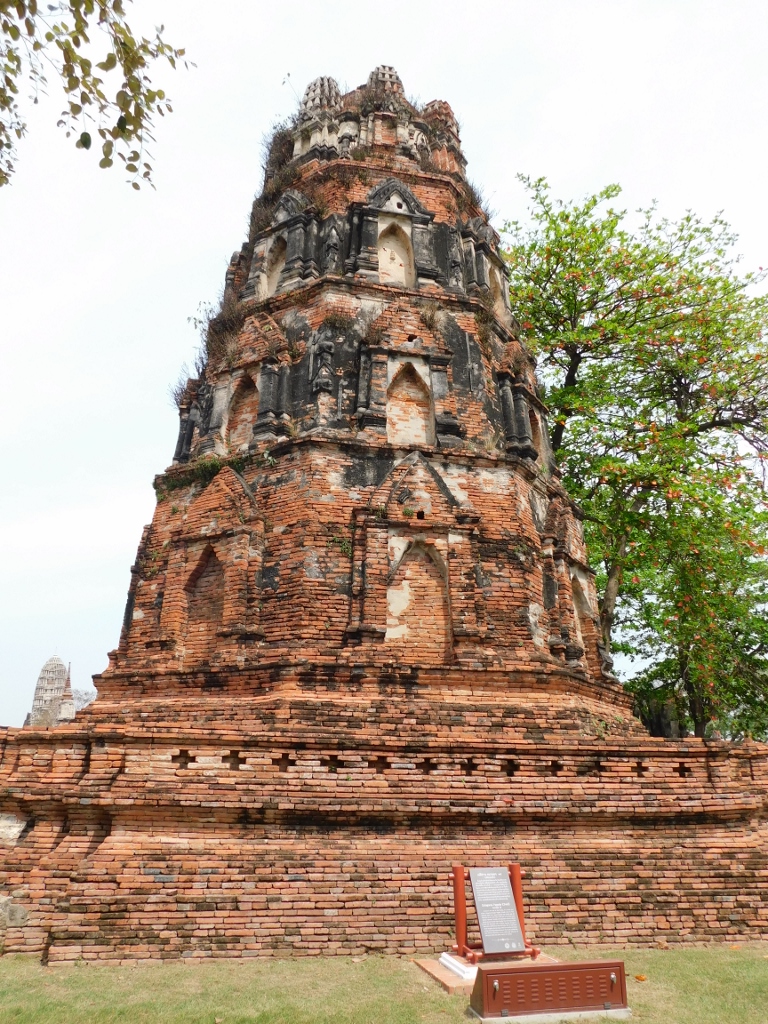 Wat Mahathat, octagonal chedi
Wat Mahathat, octagonal chedi
Now, I started a leisurely tour of the site and right near the octagonal chedi is one of the most interesting places within the Wat Mahathat temple. To begin with, one should pay attention to how vegetation tends to gradually “conquer” the products of human hands.
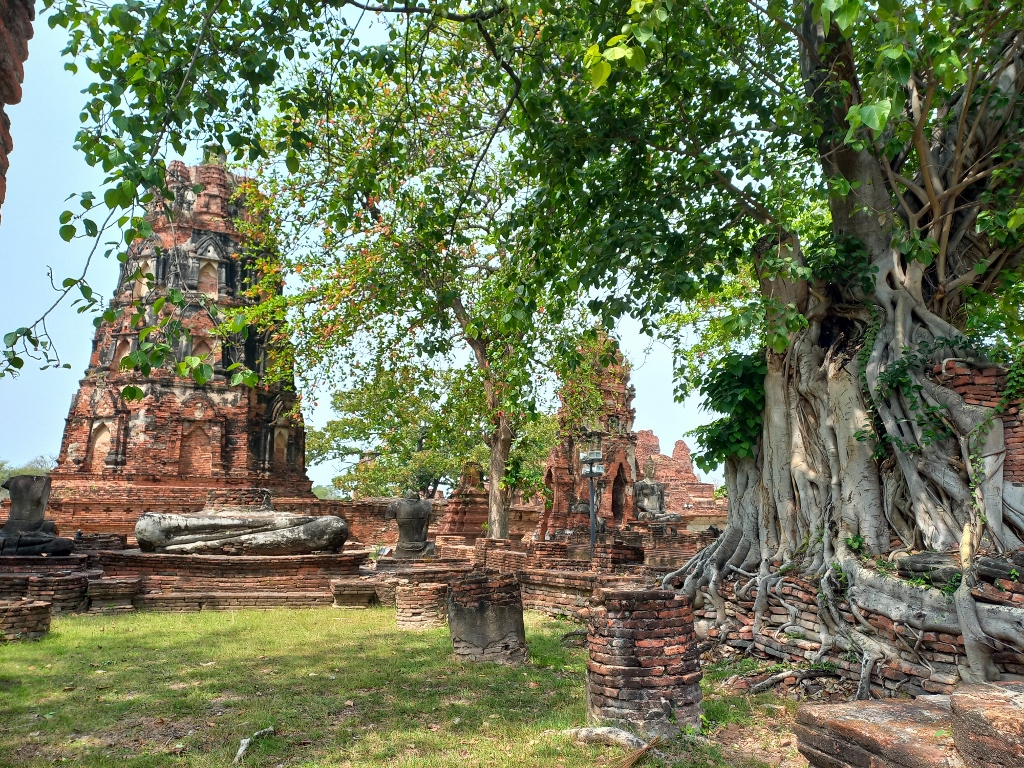 Wat Mahathat, a detail
Wat Mahathat, a detail
It is precisely the tree on the right-hand side of the previous photo that is a part of this exceptional highlight located on the other side of the tree. Namely, there you can see a Buddha head made of sandstone stuck in the intertwined aerial roots of a bodhi tree. Based on the artistic characteristics of the sculpture, it is assumed that the Buddha head was made in the mid-17th century. Over time, it detached from the body, which had meanwhile disappeared, and fell to the ground. Then it was engulfed by the aerial roots of a nearby tree. Here are the results from 2023:
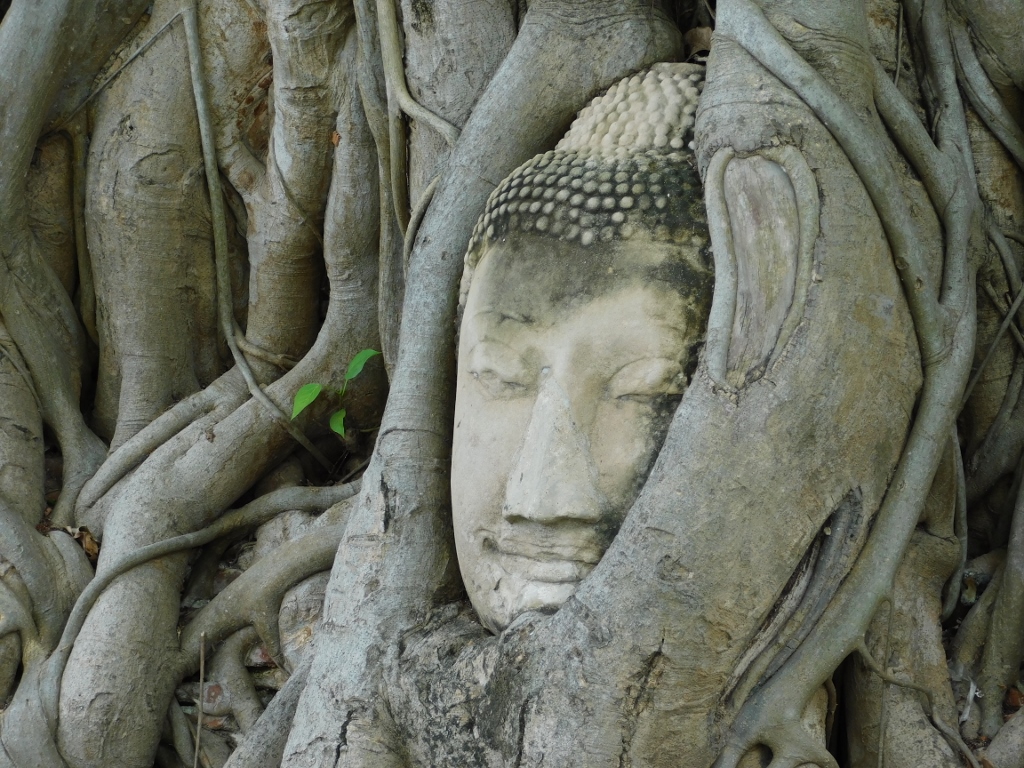 Wat Mahathat, a detail
Wat Mahathat, a detail
Since every Buddha figure is considered sacred, it is essential to observe certain rules. This includes sitting on the wooden planks laid on the ground when posing for photos at this location so that the person does not appear taller than the Buddha, as that would be considered disrespectful. Fortunately, there are always kind people willing to help by taking your photos at the spot you choose.
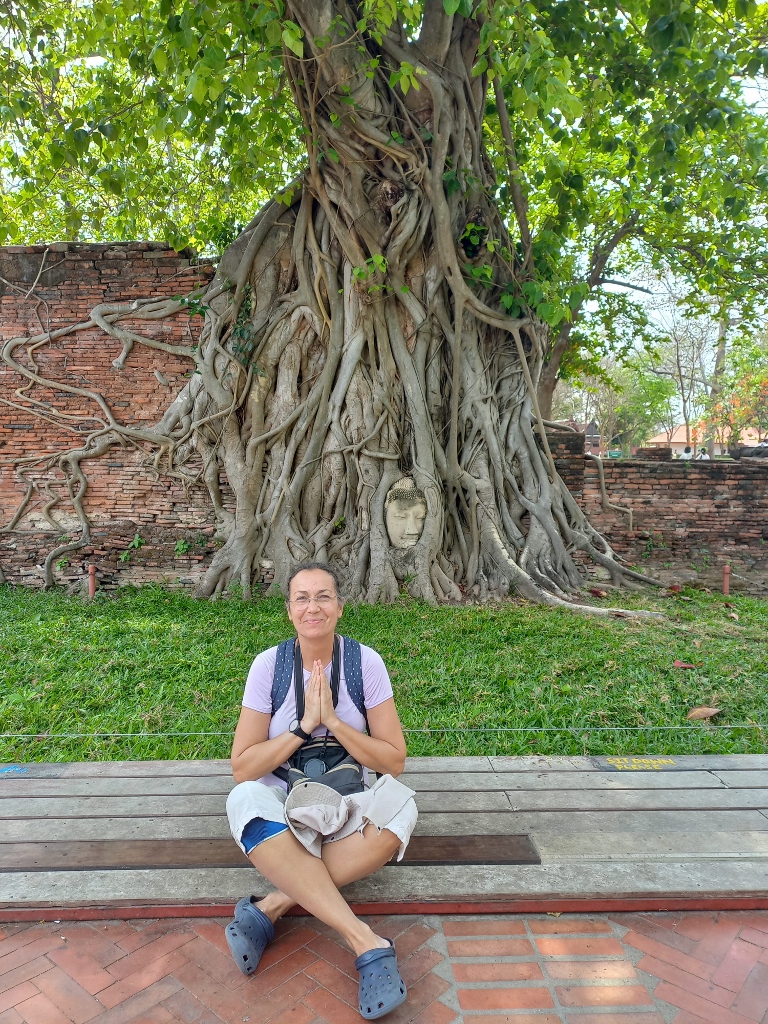 At the Wat Mahathat temple
At the Wat Mahathat temple
Near the Buddha’s Head, there are several smaller viharas and, in addition, I also noticed a couple of Asian glossy starlings (Aplonis panayensis) in a treetop.
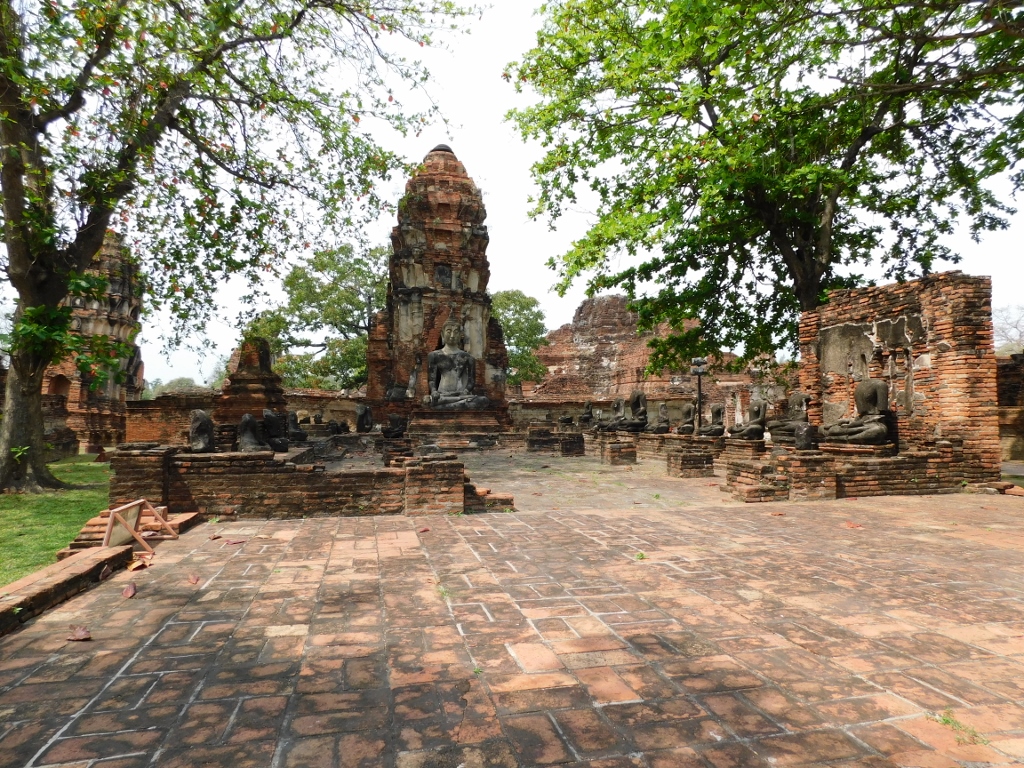 Wat Mahathat, a detail
Wat Mahathat, a detail
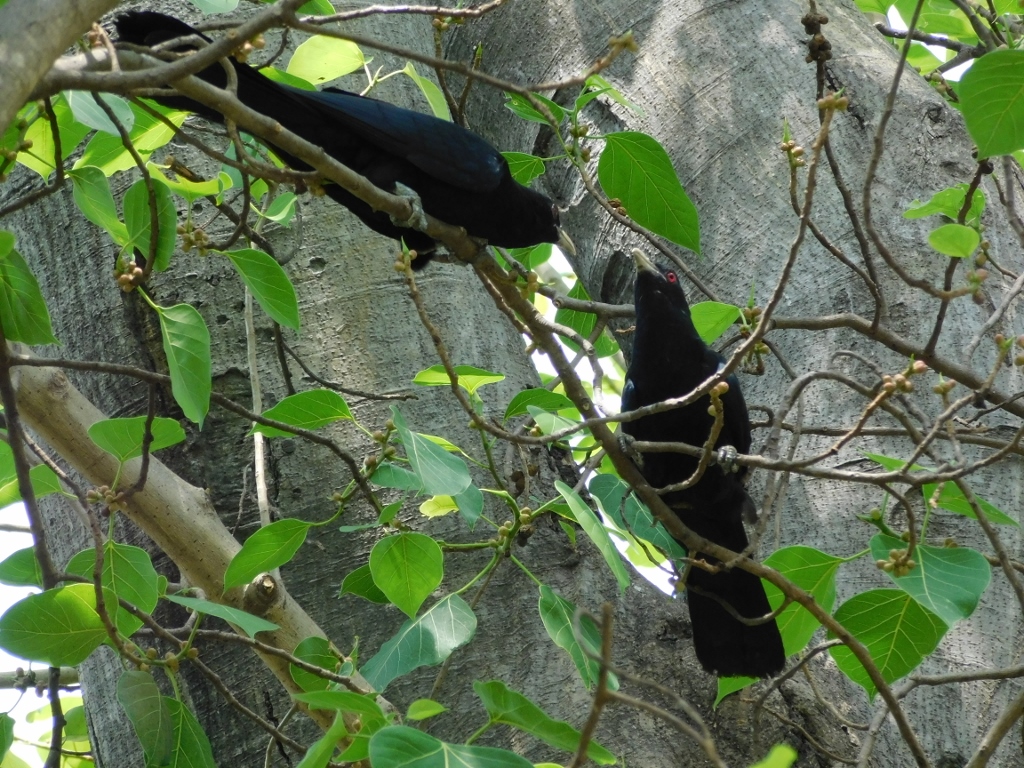 Asian glossy starlings
Asian glossy starlings
I then had to leave the pleasant shade created by the trees in this area in order to continue exploring the Wat Mahathat temple.